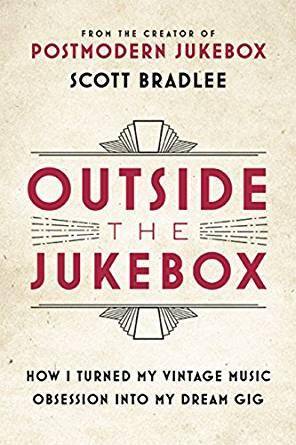 “the general public really only gets to see the ‘overnight’ part of a success story”
“the general public really only gets to see the ‘overnight’ part of a success story”
This is a story that starts in a way very familiar to readers of The Syncopated Times but ends with a level of success we rarely get to enjoy. The vehicle for that success is adapting ideas as old as recorded music to the platforms of the modern age. Touring companies with no set cast traveling under a powerful brand name, covering popular songs of the day and making them their own. Ambitious talents rising from supporting role to individual recognition and stardom. It isn’t Vaudeville, it’s Postmodern Jukebox.
Scott Bradlee initially struggled with his piano lessons as a child until the process of teaching himself “Rhapsody in Blue” grew into a fascination with jazz and ragtime. Otherwise a typical 90s kid with a bit of a rebel streak he would entertain his friends by ragging on songs of the day and even video game themes. Musically gifted, he found himself in a series of bands, went to music school, moved to New York, and by his late 20s found himself playing piano bar gigs, with student debt and a basement apartment in Queens.
Bradlee’s experiences repeatedly brushed with the creative juncture that would give him success. At his piano bar show he would take requests from the audience and adapt whatever contemporary song or golden oldie they suggested to jazz. He also set a camera on the piano and began streaming his performances while taking requests from the internet, unbeknownst to most of the live audience.
And in his basement apartment, he filmed a video of himself doing a ragtime medley of 1980s songs on his keyboard.
That video took off on the relatively uncharted medium of YouTube. It was a taste of what was to come but there were ingredients missing. He discovered the persuasive power of adding a good vocalist while secretly writing the themed early jazz elements for a video game, BioShock Infinite. Then he discovered his talent for managing artists, and the potential of an immersive vintage experience, while serving as musical director for the off-broadway production Sleep No More.
Sleep No More is a site-specific production set it The McKittrick Hotel (home to the New York Hot Jazz Fest), casting Macbeth in a film noir style with musicians and actors throughout the building. Sleep No More would have a lasting impact on the trajectory of Bradlee’s life, and some of the connections he made there would eventually play roles in the creation of Postmodern Jukebox.
That name, he says, was just a placeholder, something he tagged on a video at the last minute. It was 2010, his experience with making the video game soundtrack had led him to appear at a TedX convention which filled him with entrepreneurial ambition. He had big ideas for a project recasting Billboard hits as jazz songs, utilizing the talents of his fellow New York creatives to create a vintage feel. He wrote the arrangements and accompanied on piano while a small band played for a vocalist. The cast rotated to fit the song, even in the first videos, and his girlfriend at the time, Robyn Anderson, was an early star. They filmed the sets in a small apartment to the growing annoyance of the neighbors.
The DIY aesthetic appealed to a public itching for raw talent and a break from an overproduced music industry. The videos became viral hits, but the rest is not yet history. In this engaging autobiography Bradlee is remarkably honest about his own ambition for success, his creative hunger, and how he grew what could have been a few quirky videos into an artisitic collective racking up 100s of millions of views online.
There was nothing accidental about Postmodern Jukebox making it big. From the beginning Bradlee was making decisions with success in mind. That’s one of the many things he advises to struggling artists in this book, which sometimes reads like a self-help manual. Without knowing the name for what he was doing he would A/B test everything from lighting to length, determining which videos got the best reaction in views, shares, and comments. He wrote titles for his videos with a specific viewer in mind- the website news editors that could craft a click bait story and deliver them to a larger audience.
Success was not immediate, but he kept at it, slowly nurturing a loyal following. He also worked on related ideas like song “mashups” in case they turned out to be the right avenue. When after several years, persistent small viral successes morphed into a real and profitable career he recognized the limits of his knowledge and was quick to bring on professionals, like lawyers and promoters, who could carry him to the next step.
First was adapting what had been a social media experience into a live performance, and hoping there would be an in-person audience waiting among the online fans. He envisioned the act as a Lawrence Welk style variety show. An entertainment held together by jazz musicians. Audiences sold out limited tours in the North East and on the West Coast. Then a European tour showed the worldwide potential. They made more videos and the venues got larger.
The next step was the game changer. Feeling that his need for control was getting in the way of the creative energy of the other artists involved, Scott Bradlee left his own tour. The band that appears as Scott Bradlee’s Postmodern Jukebox has for the last several years appeared without him at the piano most of the time.
The artist roster, including show MCs, vocalists, and dancers, has grown enough to support multiple casts sometimes appearing simultaneously on different continents. Artist may follow a whole tour or join a leg of it for a few weeks. There are enough PMJ members that each show will have several recognizable stars from the Youtube channel.
Scott Bradlee has employed many up and coming jazz musicians along the way, including some familiar to Syncopated Times readers. Haruka Kikuchi, Chloe Feoranzo, Cynthia Sayer, and singer for the Glenn Crytzer Orchestra, Hannah Gill have all appeared in videos or traveled with the show. Many of the PMJ vocalists now have their own albums and solo tours. Because it has launched so many careers PMJ has been called a “Saturday Night Live for singers.”
Starting as a solo piano player and musician for hire, Scott Bradlee has grown in less than a decade into a successful producer, reinventing the role of A & R man in the process. A Ralph Peer for the new century. His role is identifying the unique thing in an artist that the public can latch onto and finding the perfect vehicle for it. Finding the song, like Macklemore’s “Thrift Shop”, that the public is ready for a cover of, and then finding just the voice, arrangement, and setting to bring it all home.
This short and very smoothly written book will please several audiences. Fans, obviously. Reading the stories behind specific videos adds something special to them. You’ll learn to place the videos by their setting as you follow the collective from basement to apartment to rented house to the new PMJ Mansion.

It will also be enjoyable to people like I was, only vaguely aware of “PMJ”, who may enjoy an occasional video of theirs without ever having heard the original of the song they are covering. Their special sauce is paying tribute to what is worthwhile in a pop song, rather than mocking it, and by doing so they welcome fans of the songs they cover to enjoy vintage jazz and other styles.
The third audience for this book is lovers of entrepreneurial biography. In other hands, the story of Postmodern Jukebox might have ended in a basement. Scott Bradlee is a harbinger of the economic landscape for musicians in the age of Youtube and Kickstarter and people in the business should listen to what he has to say.
Outside the Jukebox: How I Turned My Vintage Music Obsession into My Dream Gig, by Scott Bradlee
- Item Weight : 12.3 ounces
- Hardcover : 256 pages
- ISBN-10 : 0316415731
- ISBN-13 : 978-0316415736
- Dimensions : 5.88 x 1 x 8.5 inches
- Publisher : Hachette Books; Illustrated edition (June 12, 2018)
Joe Bebco is the Associate Editor of The Syncopated Times and Webmaster of SyncopatedTimes.com






















